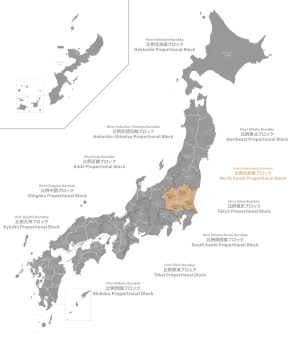| Northern Kanto Proportional Representation Block | |
|---|---|
| Parliamentary constituency for the Japanese House of Representatives | |
 Map of House of Representatives proportional blocks, with the Northern Kanto block highlighted | |
| Prefectures | Gunma, Tochigi, Saitama, Ibaraki |
| Electorate | 11,834,554[1] |
| Current constituency | |
| Number of members | 19 |
| Representatives | LDP-7, CDP-5, Komeito-3, Ishin-2, JCP-1,DPFP-1[2] |
The Northern Kanto proportional representation block (北関東比例ブロック, Kantō hokubu hirei burokku) is one of eleven proportional representation (PR) blocks for the House of Representatives in the Diet of Japan.[3][4] It consists of the northern part of the Kanto region, and consists of the prefectures of Gunma, Tochigi, Saitama and Ibaraki.[5] Proportional voting blocks were first introduced in the 1996 General Election.[6] The block elects 19 members to the House of Representatives.
See also
References
- ↑ "Number of registered electoral rolls and overseas electoral rolls for each constituency, etc". soumu.go.jp. Ministry of Internal Affairs and Communications of Japan. Retrieved 5 August 2021.
- ↑ "Results of the 2021 Japanese General Election". nhk.or.jp. NHK. Retrieved 1 December 2021.
- ↑ "Changes to Voting Age? 20 or 18?". www.ny.us.emb-japan.go.jp. Retrieved 2021-08-05.
- ↑ Berman, Daniel (2010-07-21). "In Recent Japanese Elections An Unequal Electoral System Explains the Government's Defeat". FiveThirtyEight. Retrieved 2021-08-05.
- ↑ "Northern Kantō | region, Japan". Encyclopedia Britannica. Retrieved 2021-08-06.
- ↑ Christensen, Raymond V. (1994). "Electoral Reform in Japan: How It was Enacted and Changes It May Bring". Asian Survey. 34 (7): 589–605. doi:10.2307/2645370. JSTOR 2645370.
This article is issued from Wikipedia. The text is licensed under Creative Commons - Attribution - Sharealike. Additional terms may apply for the media files.